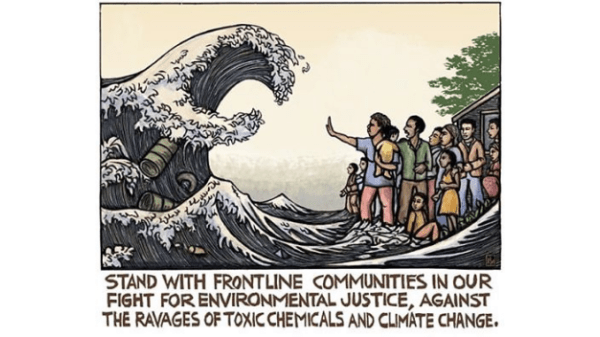Connecting Multi-Age Students with Environmental Justice


by Alejandro Ojeda and Mandie Torres
As students in an environmental justice class at the University of California Los Angeles (UCLA), we had a unique opportunity to work with middle school and high school students through a series of online collaborations to learn and raise awareness about environmental issues. “In order to address the climate crisis, humanity will need to create new systems of collaborative education that revolve around environmental stewardship and community empowerment. A glimpse of this possibility was on display through our inter-generational and inter-academic convening for the environment,” says Camino Nuevo Middle School (CNMS) teacher Emiliano Amaro. The series began with a mini-conference organized by UCLA Instructor Jeff Share, Environmental Sciences High School (ESHS) teacher Tyler Kenny, and Amaro. The event began with our first keynote speaker Karen Rodriguez from Kiss the Ground. Rodriguez gave an overview of the organization’s work and focus, explaining their mission to regenerate and restore the health of soils to achieve a balance between humans and the Earth. She went on to describe the different methods they use to achieve their vision such as media programs to create awareness, a farmland program which guides farmers into a regenerative agriculture transition, and their stewardship program to promote education and provide resources for the regeneration movement. She finished off by letting us know about volunteer farming opportunities we can be a part of in Fillmore, CA.
After hearing from Rodriguez, we also had the pleasure of welcoming Gia Chinchilla into our space to speak on the climate crisis. Chinchilla is the founder of Climate Action Lab, an organization that provides information and resources to youth interested in tackling climate-related issues in their communities. Having her present to us was fitting for our conference, as she has been doing for years what we were accomplishing that day: collaborating with other youth to empower our message and bring attention closer to the climate justice movement. Her organization has a growing presence on social media, particularly Instagram, where she continues to advocate for climate justice and shine a spotlight on efforts being made by youth in the Los Angeles area. Before our poster making began, she gave students tips for creating pieces of advocacy. It was enlightening to say the least, as we were learning more about the efficacy of visual calls to action in supporting environmental issues.
In breakout rooms we co-created public service announcement (PSA) posters that brought an environmental issue to light. Prior to class, students were asked in a survey about the topics they were most interested in, and based on that information, students from different schools were placed into groups with others who shared the same interest in the topic. The topics ranged from climate denial, to alternative energy, to air quality, and much more. There were a total of 16 groups with an average of two UCLA students, one ESHS student, and one CNMS student per group. Once in the breakout room, students introduced themselves and shared why they care about climate change. Each group member chose a role for creating the poster (designer, image finder, researcher, or writer), and together they discussed the topic, identified the problem, and brainstormed possible solutions. Designers were in charge of creating the poster by choosing the border, fonts, colors, etc. The image finder searched for images that reflected the environmental issue, the researcher looked up the issue and solution, and the writer typed out short descriptions of the problem and solutions. If the students had time after creating their posters, they also looked for a supporting organization and a song that was relevant to the issue. We then uploaded our posters to a shared Google Slides presentation in which every group’s poster was available to be seen. Here are examples of some of the collaborative posters created by students:

The first follow-up session to the conference has been in the form of student interviews so that the students involved can reconnect and continue the conversations that were started during our first conference. This time, there has been a stronger focus on Indigenous worldviews and perspectives. All the students responded to the short video “The Honorable Harvest,” featuring Robin Wall Kimmerer. The middle and high schoolers video recorded themselves asking questions about this to the UCLA students through the online platform Flipgrid. UCLA students responded by video recording themselves answering the questions and then posing questions in return so that the process was reciprocal, rather than only having the younger students asking the older students for their knowledge. While the online ability to video record ourselves enabled us to continue our conversations and deepen our relationships, it was not the same as actually being together physically and talking. Not all students recorded videos and few questions were asked and answered. Yet, this asynchronous online space did create an opportunity for those interested to continue collaborating. This activity also helped students prepare for our final event by providing background knowledge and conversations about Indigenous worldviews and perspectives. Kenney discusses his excitement about the continued collaboration: “This is an exciting project! The students feel energized at the potential of meeting UCLA students and collaborating with their middle school pen pals. Anything that provides traditional education students with unique learning opportunities has awesome results with engagement. In the days of virtual learning this has posed a challenge to me as a teacher. However, thanks to the tireless commitment of Share and Amaro, we have used our passion for Environmental Justice to connect these students and provide them with a rare opportunity to connect over their shared interests. The agency that they had in choosing topic groups, the preparation work they completed in designing individual posters and gaining confidence with broadcasting environmental justice messages and the pride they took in having something to contribute made them special. While I wish that this was possible for all my cohorts, our shared work gave me the creative freedom and experimentation space to build out these same projects within my other classes. I am excited to continue to let our students do the talking!”


Although there are generally many limitations to remote environments that can include technical difficulties, lack of in-person interaction, and Zoom fatigue, this course has shown us the positive potential as well. The online environment encouraged us to be creative with our interactions and in a sense was fundamental to the creation of our multi-age collaborations and conferences. Being online created accessibility for people from different classes to interact and get to know each other, as well as bring guest speakers from around the world. We have been grateful for having this opportunity to work with youth especially on a topic that we are passionate about. As aspiring teachers, we want to implement an environmental justice curriculum wherever we go, so this course has given us a transformational experience, practical tools, and a wide-range of resources to apply toward our future goals.






Comments
This is great! Thanks! More like this, please....